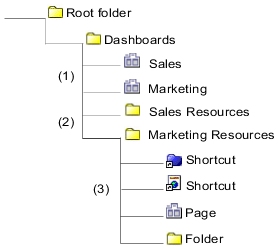Create a Dashboard with Multiple Tabs
Different segments of information are displayed on different tabs. To create a dashboard, you assemble the different segments of information into a single view by using the Multi-page portlet. For more information, see Pages and Dashboards. This portlet is linked to a source folder that contains entries that appear as tabs in the dashboard. You can make changes to the tabs in the dashboard by adding or deleting the associated entries from the source folder.
The following entries can be used as tabs in a dashboard:
- folders and shortcuts to folders
Use folders to include a second level of tabs.
- packages and shortcuts to packages
Use packages to include a second level of tabs.
- reports and shortcuts to reports
Use to view or run a Report Studio report.
- report views and shortcuts to report views
Use to view or run a Report Studio report.
- queries and shortcuts to queries
Use to view or run a Query Studio report.
- analysis and shortcuts to analysis
Use to view or run an Analysis Studio report.
- pages and shortcuts to pages
Use to add a page or another dashboard
- URLs and shortcuts to URLs
Use to embed a different Web page.
- PowerPlay® reports
Use to view or run a PowerPlay report
- Microsoft Documents
Use to include a link to a Microsoft document, such as an Excel, PowerPoint, or Word document.
The general dashboard properties are the same as page properties. You can edit the dashboard layout and style Edit a Page, modify the properties of the Multi-page portlet Modify a Portlet, set up access permissions for the dashboard Share a Page, and add it to the portal tabs Portal Tabs.
Before you start creating your dashboards, we recommend setting up a folder hierarchy in Public Folders to keep your dashboard resources organized. For example, create a folder for all the dashboards you plan to create. Next, create a subfolder for each dashboard to use as source folder for the entries that you want to include in the dashboard, such as reports, folders, pages, or shortcuts. The folder structure may look like this:

- The Sales and Marketing pages are the multi-tabbed dashboards. These are the dashboard master pages that are built using the Multi-page portlet.
- The Sales Resources folder is the source folder for the Sales dashboard, and the Marketing Resources folder is the source folder for the Marketing dashboard.
- The source folders can contain entries such as reports, pages, folders, shortcuts, and so on. These entries appear as tabs in the dashboard.
Procedure
Results
Tip: Other users can access the dashboard through its URL. To see the URL, go to IBM Cognos Connection, locate the dashboard master page, and open its properties page. On the General tab, click View the search path, ID and URL.

 .
.  to move the portlet to the
to move the portlet to the .
.